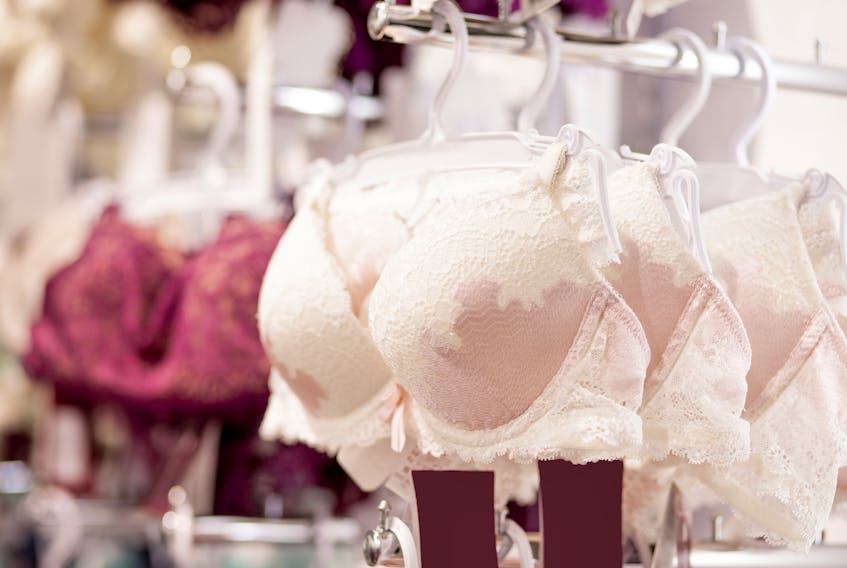Since she started working from home, Janis Keirstead has ditched wearing a bra.
In fact, the Halifax, N.S. woman now finds herself walking around more publicly without one, too.
“It feels so much better,” she says.
Although she says she will probably never completely stop wearing a bra, she’s one of many women who are now wearing one significantly less, especially since COVID-19.
“Set them free,” jokes Keirstead.
Nikki Gordon, from Cape Breton, N.S., ditched the underwire a few months ago and started wearing tank top bras and sports bras instead, calling it the "best decision ever." She found the underwire dug into her skin and was uncomfortable. She hasn’t thrown out her bras completely; instead, she's just put them away for special occasions.
“You know, when you need a lift,” she laughs.

Evolution of bras
Wanting to be comfortable is always something women have desired, says Liz Huntley, owner of the Swimwear Hut and Lingerie in New Minas, N.S.
Most women, says Huntley, are looking for three things in a bra: support or lift, a little style, and a lot of comfort. Over the past decade, the wire-free bra has certainly evolved, as many modern bras now do offer all three of these features, she says.
But that wasn't always the case. In 2015, the Kings County Museum in Kentville, N.S. featured an exhibit called “A Brief History of Underwear,” which highlighted the bra.
According to the information panels created to accompany the exhibit, the bra originates from the corset, explains Kate MacInnes Adams, office manager at the museum. The invention of the bra allowed for the elimination of the restrictive midsection of the corset while maintaining chest support.
Bras increased in popularity at the beginning of the 20th century but did not become a part of mainstream manufacturing until the 1930s.
A young woman was working with the museum and doing research to put together interpretive panels for the exhibit, says MacInnes Adams.
"I remember one of her interpretive panels had a strong message: Whether it was a tight-laced corset, chest binder, or bullet bra, women’s undergarments were rarely made for comfort or practicability," she says.
Rather, they were designed to morph women into the ideal body type for the era, "perfecting their image for male consumption,” it originally read.
The statement was later edited, but the sentiment remained, said MacInnes Adams. Bras were designed to morph women into the ideal body type for the era.
The best fit
These days, Huntley says the bra continues to evolve with wire-free alternatives, including the bralette.
Huntley says the main difference between a bra and a bralette is that a bra is a more structured undergarment that enhances your shape. Bras are more traditional and typically contain underwire, defined cups, can have some padding, adjustable straps, hook and eye closures, are functional, and vary in degrees of coverage.
A bralette typically is something you pull on over your head and are worn more for style and comfort, rather than functionality. Bralettes are typically more of a casual undergarment, provide light coverage and support, can be made out of stretchy fabric or lace, do not have adjustable straps, and are better suited for women with smaller bust sizes, explains Huntley.
There are, however, some newer bralette options for women with larger busts that have been transformed to be quite supportive, uplifting, and comfortable in size ranges up to an E/F cup, she adds.
“It’s great to see that the bralette is available to many and can even become an everyday piece you wear to work or just about any place you desire. It is a stylish, feminine, yet a classic touch that can spice up any outfit,” says Huntley.
Underwire bras are here to stay as well because they do a great job lifting and supporting our breasts - as long as you are wearing a proper-fitting bra.
The proper fit is more important than any fashion trend, says Huntley. Women can get properly fitted at any lingerie store, and it can mean less back and muscle pain, less stress on the shoulders, a nice lift which results in a nice silhouette, and, overall, feeling really good about yourself.
But the number of women wearing an improper size bra is staggering.
"Approximately 80 per cent of ladies are wearing the wrong bra size," says Huntley.
"An ill-fitting bra can impact your health. It can cause poor posture, back and neck pain, shoulder grooves leading to numbness and a lack of self-confidence. Your breast health is the main priority."

Benefits?
When asked if wearing a bra is good for you, Judy Donovan Whitty, a retired nurse and a member and support contact for the P.E.I. Breast Cancer Information Partnership, says it is an individual comfort decision, just as women who choose to wear a prosthesis after a mastectomy.
"Women who are endowed with large breasts have been known to state that they are more comfortable wearing a bra, however, as it does provide some stable support," says Donovan Whitty.
There has been controversy as to whether women should be wearing underwire bras, but nothing has been proven, and bras do not weaken the muscles in that area. Huntley further says that in all her professional development training, she's been taught that bras do not cause harm if they are worn properly.
The larger concern for Donovan Whitty is that women should know the density level of their breast tissue.
"Those with high-density tissue should know that, and in P.E.I., it is being reported within the report now," she says. "So, if a woman being screened receives that info, and the density is 50 per cent or higher, if no one suggests she have an ultrasound, she would be wise to ask her physician to request one."
Those who have had breast cancer and do not know their density rate, she says, should have this told to them as well and it is not currently; that is what Breast Density Canada is advocating for cross Canada, she adds.
"Knowing your body, taking care of your own health, making your own decisions are key," she says.
Overall, whether they wear a bra or not, women should feel empowered by how beautiful they feel and look both inside and out.








